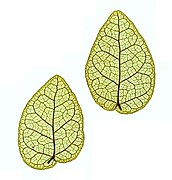Ficus pumila
| Creeping fig | |
|---|---|

| |
| F. pumila foliage | |
| Scientific classification | |
| Kingdom: | Plantae |
| Clade: | Tracheophytes |
| Clade: | Angiosperms |
| Clade: | Eudicots |
| Clade: | Rosids |
| Order: | Rosales |
| Family: | Moraceae |
| Tribe: | Ficeae |
| Genus: | Ficus |
| Subgenus: | F. subg. Synoecia |
| Species: | F. pumila
|
| Binomial name | |
| Ficus pumila | |
| Synonyms[1] | |
|
List
| |
Ficus pumila, commonly known as the creeping fig or climbing fig, is a species of flowering plant in the mulberry family, native to East Asia (China, Japan, Vietnam)[2] and naturalized in parts of the southeastern and south-central United States.[3][4] It is also found in cultivation as a houseplant. The Latin specific epithet pumila means "dwarf",[5] and refers to the very small leaves of the plant.
Description
[edit]Ficus pumila is a woody evergreen liana, growing to 2.5–4 m (8 ft 2 in – 13 ft 1 in). It can grow up to 9–12 m (30–39 ft) tall if it isn't regularly pruned.[6] The juvenile foliage is much smaller and thinner than mature leaves produced as the plant ages. The leaves are oval, cordate, asymmetrical, with opposite veins. It is creeping or can behave like a liana and also climb trees, rocks, etc. up to 4 m in height or more. The aerial roots secrete a translucent latex that hardens on drying, allowing the sticks to adhere to their support.[citation needed]
Cultivation
[edit]As the common name, "creeping fig" indicates, the plant has a creeping/vining habit and is often used in gardens and landscapes where it covers the ground and climbs up trees and walls. It is hardy down to 1 °C (34 °F)[7] and does not tolerate frost. Therefore in temperate regions it is often seen as a houseplant. It is fast-growing and requires little in the way of care. It can be invasive when environmental conditions are favorable. Its secondary roots or tendrils can cause structural damage to certain buildings with fragile mortar or structures made of fragile materials.
It has gained the Royal Horticultural Society's Award of Garden Merit.[8]
The plant requires the fig wasp Blastophaga pumilae for pollination, and is fed upon by larvae of the butterfly Marpesia petreus.[citation needed]
Varieties and cultivars
[edit]- Ficus pumila var. awkeotsang — awkeotsang creeping fig
- Ficus pumila var. quercifolia — oak leaf creeping fig
- Ficus pumila 'Curly' — curly creeping fig; crinkled leaf form
- Ficus pumila 'Variegata' and Ficus pumila 'Snowflake' — variegated creeping fig; variegated foliage
Cuisine
[edit]The fruit of Ficus pumila var. awkeotsang is used in cuisine. In Taiwan, its fruit is turned inside out and dried. The seeds are scraped off and a gel is extracted from their surface with water and allowed to set and form a jelly known in Taiwan as aiyu jelly (or aiyuzi 愛玉子) and in Singapore as ice jelly (文頭雪).
Toxicity
[edit]Like other plant species in the family Moraceae, contact with the milky sap of Ficus pumila can cause phytophotodermatitis,[9] a potentially serious skin inflammation. Although the plant is not poisonous per se, F. pumila is listed in the FDA Database of Poisonous Plants.[10]
Gallery
[edit]-
Habit on a wall
-
Vigorous growth on a wall
-
Close-up of the leaves and brown stipules
-
Nature printed leaves, showing shape and venation
-
Syconia (figs)
-
Inverted and dried fig of F. p. var. awkeotsang, ready for use
-
Leaves from oldest to youngest
-
Variegated leaves
-
Half cut of Ficus Pumila Syconia
References
[edit]- ^ The Plant List, Ficus pumila L.
- ^ Flora of China, Ficus pumila Linnaeus, 1753. 薜荔 bi li
- ^ Flora of North America, Ficus pumila Linnaeus, 1753. Climbing fig
- ^ Biota of North America Program 2014 county distribution map
- ^ Gaffiot, Félix (1934). Dictionnaire illustré Latin-Français (in French). Paris: Librairie Hachette. p. 1278. Retrieved 23 October 2016.
- ^ Ficus Species, Climbing Fig, Creeping Ficus, Creeping Fig by Dave's Garden
- ^ "AGM Plants - Ornamental" (PDF). Royal Horticultural Society. July 2017. p. 39. Retrieved 27 February 2018.
- ^ "Ficus pumila AGM". Royal Horticultural Society. Retrieved 4 July 2020.
- ^ Rademaker, M.; Derraik, J. G. (July 2012). "Phytophotodermatitis caused by Ficus pumila". Contact Dermatitis. 67 (1): 53–56. doi:10.1111/j.1600-0536.2012.02026.x. PMID 22681467. S2CID 39421000.
- ^ "FDA Poisonous Plant Database". U.S. Food & Drug Administration. Archived from the original on 4 October 2022. Retrieved 11 December 2018.










